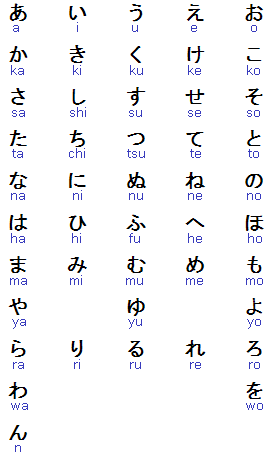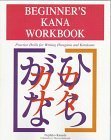
|
BAHASA |
|||||||||||||||||||||||||||||||||||||||||||||||||||||||||||||||||||||||||||||||
|
bahasa japan
|
|||||||||||||||||||||||||||||||||||||||||||||||||||||||||||||||||||||||||||||||
| bahasa jawa | bahasa korea | bahasa rusia | bahasa japan | bahasa arab | bahasa cina | |||||||||||||||||||||||||||||||||||||||||||||||||||||||||||||||||||||||||||||||
|
Around the 9th century, the Japanese developed an own writing system based on syllables: Hiragana and katakana (together: Kana). Of the two kana systems, hiragana is more cursive while katakana characters are more angular.
Hiragana and katakana each consist of 46 signs which originally were kanji but were strongly simplified over the centuries. When looking at a Japanese text, one can clearly distinguish the two kinds
of signs: the complicated kanji and the simpler kana signs.
Among the syllables are 5 vowels (a i u e o). The rest are syllables combined by one of these vowels with a consonant (ka
ki ku ke ko ra ri ru re ro...). One exception is the n. In addition, many syllables can be softened or hardened by adding
two small strokes or a small circle in the top right corner next to the character.
Even though one can theoretically write the whole language in hiragana, it is usually used only for grammatical endings
of verbs, nouns, and adjectives, as well as for particles, and several other original Japanese words (in contrast to loan words that are written in katakana) which are not written in kanji.
Hiragana is the first of all the writing systems taught to Japanese children. Many books for young children are, therefore,
written in hiragana only.
Any question, advice or opinion? Voice them in the forum!
Hiragana and Katakana each consist of 46 signs which originally were kanji but were strongly simplified over the centuries. When looking at a Japanese text, one can clearly distinguish the two kinds
of signs: the complicated kanji and the simpler kana signs.
Among the syllables are 5 vowels (a i u e o). The rest are syllables combined by one of these vowels with a consonant (ka
ki ku ke ko ra ri ru re ro ...). One exception is the n. In addition, many syllables can be softened or hardened by adding
two small strokes or a small circle in the top right corner next to the character.
Katakana is mainly used for writing loan words and the names of persons and geographical places that can't be written in kanji.
 Katakana table Any question, advice or opinion? Voice them in the forum!
Over the centuries, many words from foreign languages were incorporated into the Japanese language, especially from the Chinese and English languages. A large amount of Chinese words was adapted together with the Chinese writing system in the 5th century and afterwards. Chinese loan words are naturally written in kanji (Chinese characters). In more recent times, many words were also borrowed from Portuguese, Dutch, German (especially from the fields of medicine and mountaineering), French and Italian (especially from the fields of music and food), and, of course, English which is the origin of most modern loan words. Non Chinese loan words are written in katakana. Loan words are often heavily Japanized in various ways (see below), which is a complicating factor not only for students of the Japanese language but also for Japanese students of foreign languages:
Any question, advice or opinion? Voice them in the forum!
There are several levels of politeness in the Japanese language: a colloquial, a more polite, and a very polite, honorific level (keigo). You are supposed to speak in a honorific language to people who are of much higher social status than yourself, for example, to customers, teachers, elder people, etc. Basically, very humble expressions are used when referring to yourself and very honorific ones when referring to the person you are addressing. According to the level of politeness, verb endings differ or whole alternative expressions and words are used. Even a Japanese person needs much exercise in order to be able to correctly express herself/himself in a formal, honorific way. Any question, advice or opinion? Voice them in the forum!
|
|||||||||||||||||||||||||||||||||||||||||||||||||||||||||||||||||||||||||||||||
|
Enter content here |
|||||||||||||||||||||||||||||||||||||||||||||||||||||||||||||||||||||||||||||||
|
Enter supporting content here |





